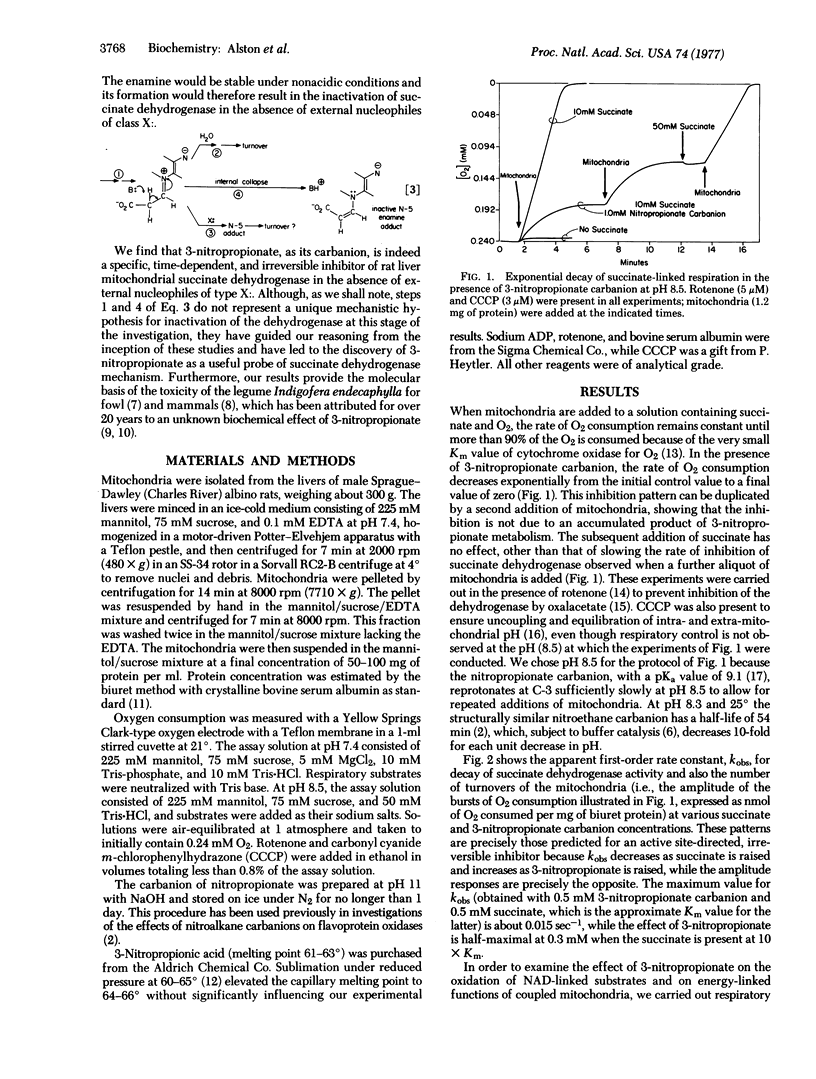Abstract
We have shown that 3-nitropropionate, an isoelectronic analogue of succinate, is a suicide inactivator of succinate dehydrogenase [succinate:(acceptor) oxidoreductase, EC 1.3.99.1] as follows. (i) When rat liver mitochondria oxidize succinate in the presence of 3-nitropropionate carbanion, the rate of O2 consumption decreases exponentially to a zero value. This pattern is duplicated by subsequent additions of mitochondria. The dependence of the apparent first-order rate constant for enzyme inhibition, as well as the number of enzyme turnovers completed before inhibition, on the concentrations of 3-nitropropionate carbanion and succinate are those expected for an active site-directed and irreversible inhibitor. (ii) The inactivated enzyme is not resuscitated by centrifugation and washing of the mitochondria, in contrast to malonate-treated enzyme, and malonate protects against irreversible, inhibition. (iii) The inhibitor species is 3-nitropropionate carbanion and no external nucleophile is required for inhibition. (iv) The respiratory rates, respiratory control ratios, and ADP/O ratios obtained with NAD-linked substrates are unaffected by 3-nitropropionate carbanion. These results show that 3-nitropropionate carbanion is a highly specific, time-dependent, and irreversible inhibitor of succinate dehydrogenase. By analogy with the reaction of nitroethane with D-amino acid oxidase, the data are consistent with the hypothesis that the carbanionic inhibitor forms a covalent N-5 adduct with the active site flavin. However, the precise mechanism of inactivation, as well as mechanistic extrapolations to the oxidation of succinate, must await the elucidation of the structure of the modified enzyme. We can now explain the toxicity of plants such as Indigofera endecaphylla for mammals and fowl as being due to the irreversible blockage of the Krebs cycle by 3-nitropropionate carbanion.
Keywords: rat liver mitochondria, carbanion, N-5 flavin adducts, two-proton abstraction mechanism
Full text
PDF




Selected References
These references are in PubMed. This may not be the complete list of references from this article.
- BUSH M. T., TOUSTER O., BROCKMAN J. E. The production of beta-nitropropionic acid by a strain of Aspergillus flavus. J Biol Chem. 1951 Feb;188(2):685–693. [PubMed] [Google Scholar]
- Brodie J. D., Nicholls P. Metabolism and enzymology of fluorosuccinic acids. I. Interactions with the succinate oxidase system. Biochim Biophys Acta. 1970 Mar 18;198(3):423–437. doi: 10.1016/0005-2744(70)90121-x. [DOI] [PubMed] [Google Scholar]
- CHANCE B., WILLIAMS G. R. The respiratory chain and oxidative phosphorylation. Adv Enzymol Relat Subj Biochem. 1956;17:65–134. doi: 10.1002/9780470122624.ch2. [DOI] [PubMed] [Google Scholar]
- Chance B. Reaction of oxygen with the respiratory chain in cells and tissues. J Gen Physiol. 1965 Sep;49(1 Suppl):163–195. doi: 10.1085/jgp.49.1.163. [DOI] [PMC free article] [PubMed] [Google Scholar]
- HYLIN J. W., MATSUMOTO H. INHIBITION OF SUCCINIC DEHYDROGENASE BY 3-NITROPROPANOATE. Ther Ggw. 1964 Mar;103:168–171. doi: 10.1016/0041-008x(64)90102-4. [DOI] [PubMed] [Google Scholar]
- Lutton J. D., Kopac M. J. Cartesian diver studies on respiration and glycolysis of high and low sarcoma lines. Cancer Res. 1971 Nov;31(11):1564–1569. [PubMed] [Google Scholar]
- Morisaki M., Bloch K. On the mode of interaction of -hydroxydecanoyl thioester dehydrase with allenic acid derivatives. Biochemistry. 1972 Feb 1;11(3):309–314. doi: 10.1021/bi00753a001. [DOI] [PubMed] [Google Scholar]
- Morris M. P., Pagán C., Warmke H. E. Hiptagenic Acid, a Toxic Component of Indigofera endecaphylla. Science. 1954 Mar 5;119(3088):322–323. doi: 10.1126/science.119.3088.322. [DOI] [PubMed] [Google Scholar]
- Porter D. J., Bright H. J. Mechanism of oxidation of nitroethane by glucose oxidase. J Biol Chem. 1977 Jun 25;252(12):4361–4370. [PubMed] [Google Scholar]
- Porter D. J., Voet J. G., Bright H. J. Direct evidence for carbanions and covalent N 5 -flavin-carbanion adducts as catalytic intermediates in the oxidation of nitroethane by D-amino acid oxidase. J Biol Chem. 1973 Jun 25;248(12):4400–4416. [PubMed] [Google Scholar]
- Porter D. J., Voet J. G., Bright H. J. Nitroalkanes as reductive substrates for flavoprotein oxidases. Z Naturforsch B. 1972 Sep;27(9):1052–1053. doi: 10.1515/znb-1972-0914. [DOI] [PubMed] [Google Scholar]
- Porter D. J., Voet J. G., Bright H. J. Nitromethane. A novel substrate for D-amino acid oxidase. J Biol Chem. 1972 Mar 25;247(6):1951–1953. [PubMed] [Google Scholar]
- RAISTRICK H., STOSSL A. Studies in the biochemistry of micro-organisms. 104. Metabolites of Penicillium atrovenetum G. Smith: beta-nitropropionic acid, a major metabolite. Biochem J. 1958 Apr;68(4):647–653. doi: 10.1042/bj0680647. [DOI] [PMC free article] [PubMed] [Google Scholar]
- Van Dam K. The inhibitory effect of uncouplers of oxidative phosphorylation on mitochondrial respiration. Biochim Biophys Acta. 1967 Mar 8;131(2):407–411. doi: 10.1016/0005-2728(67)90157-0. [DOI] [PubMed] [Google Scholar]
- Walsh C. T., Schonbrunn A., Abeles R. H. Studies on the mechanism of action of D-amino acid oxidase. Evidence for removal of substrate -hydrogen as a proton. J Biol Chem. 1971 Nov 25;246(22):6855–6866. [PubMed] [Google Scholar]


